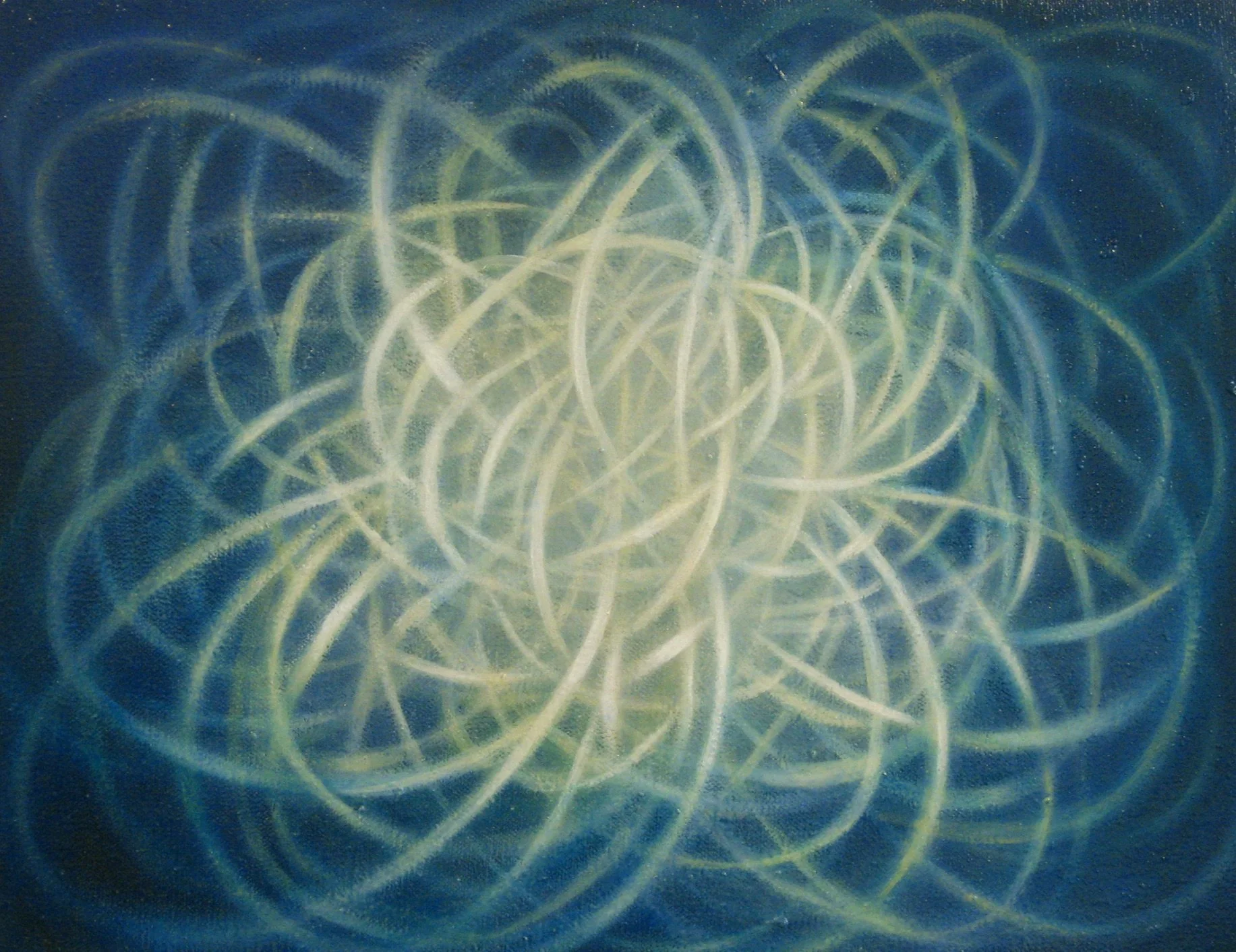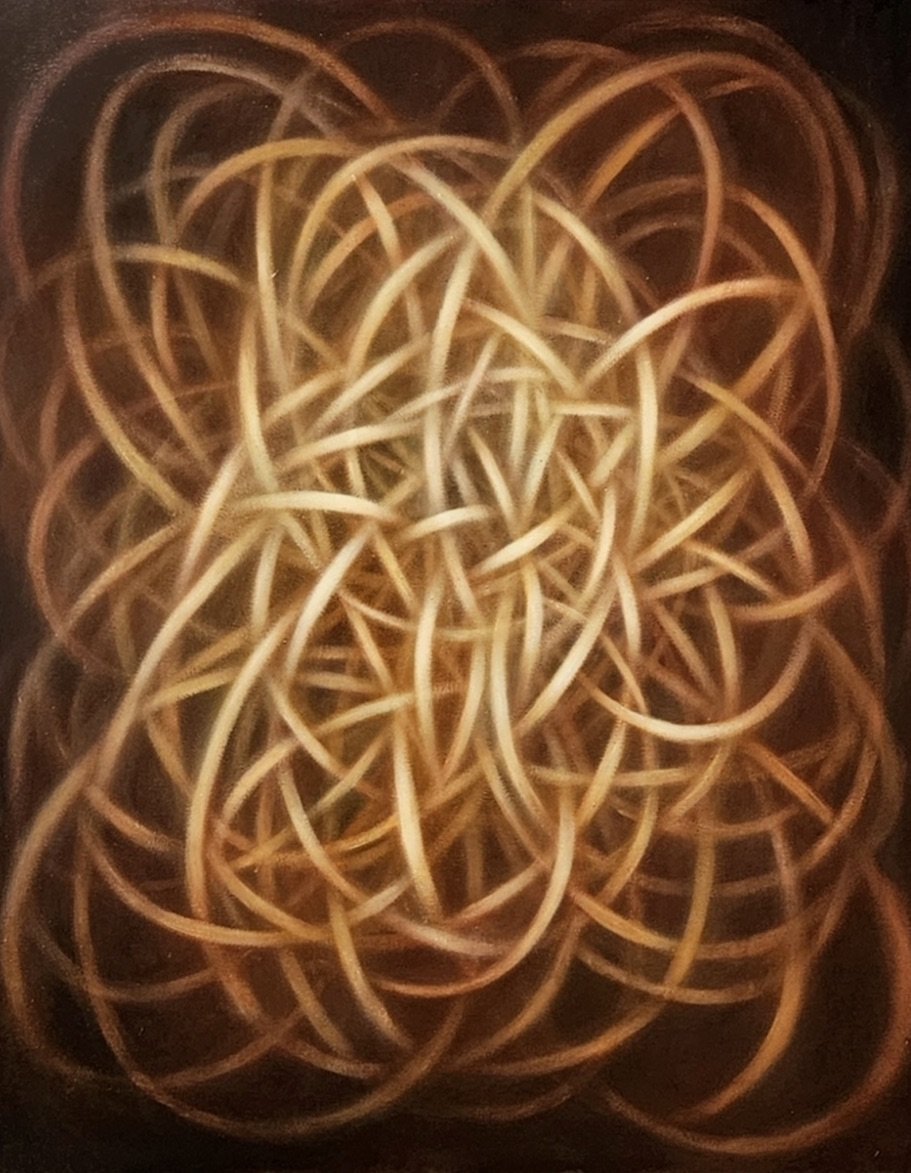The Surface Glittered out of the Heart of Light - At the Still Point of the Turning World
2018-2024, oil on canvas, 60 × 84 inches
SHANE GUFFOGG: Where Past and Future are Gathered
Gallery Chang, Seoul, South Korea
April 10 – May 24, 2025
Gallery Chang in Seoul, South Korea, presents Shane Guffogg: “Where Past and Future are Gathered,” a solo exhibition featuring the artist’s Still Point paintings—a body of work profoundly engaged with the temporal, the transcendent, and the liminal space between material and immaterial realms. Though this marks Guffogg’s debut in South Korea, the contemplative ethos of his practice resonates deeply with Korean artistic traditions that privilege intuition, simplicity, and the expression of inner spirit.
Guffogg’s paintings are temporal palimpsests—confessions of time rendered visible through veils of light and motion. His layered brushwork transforms invisible forces into tangible presence, echoing the efforts of artists across history who have sought to translate metaphysical truths into visual form. Like the Symbolists of the 19th century who viewed art as a bridge to the unseen—Odilon Redon or Gustave Moreau—Guffogg’s canvases function as conduits, inviting the viewer to a visual and spiritual communion.
A central source of inspiration for the Still Point series is T.S. Eliot’s Four Quartets, a poetic meditation on time, impermanence, and spiritual awakening. Each painting is titled after a line from the poem, echoing the metaphysical preoccupations that Eliot shared with mystics and modernists alike. The integration of poetry and painting in Guffogg’s work recalls the Gesamtkunstwerk (total work of art) ideal pursued by artists such as Wassily Kandinsky, who believed that painting could express spiritual reality through abstraction—an ideal echoed in Guffogg’s own synesthetic approach.
At the Still Point #19, 2010, 12 x 16 inches
Yet Guffogg does not merely illustrate Eliot’s verses. His paintings embody a calligraphic rhythm where color and movement become gestural expressions of thought and feeling—akin to the lyrical abstraction of Cy Twombly or the spiritual modernism of Mark Rothko, whose color fields were not compositions, but sanctuaries. Through thousands of translucent brushstrokes, Guffogg’s paintings unfold like wordless poems—abstract psalms for the present moment.
The exhibition’s monumental painting, “At the Still Point of the Turning World – The Surface Glittered out of the Heart of Light”, conjures Eliot’s meditation on time as both linear and cyclical. The luminous strata of paint evoke the sfumato and chiaroscuro of the Old Masters— Leonardo, Rembrandt, and Vermeer—yet their abstract language speaks to the contemporary need for stillness amid flux. Guffogg’s command of light and shadow nods to this lineage, but his surfaces shimmer with a uniquely modern tension: presence and absence, solidity and fluidity, stillness and motion.
His process is devotional. Working in seclusion on his California ranch, surrounded by the rhythms of the natural world, Guffogg paints 8 to 10 hours a day. Charcoal inscriptions of Eliot’s verses line the studio walls, gradually becoming internalized until each word finds its resonance in color. This meditative discipline echoes traditions from both Western and Eastern art histories—evoking the studio practices of Cézanne in Aix or the Zen-infused discipline of Korean muninhwa (literati painting).
One of the most evocative pieces in the exhibition, “At the Still Point of the Turning World – Into the Rose Garden”, renders a symphony of reds, purples, and soft whites—a visual evocation of Eliot’s symbolic garden, where time dissolves and transformation begins. Gardens, both literal and metaphorical, have long been sites of philosophical inquiry in art—from the Persian paradise garden to Monet’s Giverny. In Guffogg’s hands, the garden becomes not a subject, but a state of being.
Alongside the Still Point series, the exhibition features selections from Guffogg’s “The Counting of Days” and “The Rose is a Rose is a Rose” series—bodies of work that expand his meditation on time, memory, and identity. “The Counting of Days” is a visual diary, each canvas a contemplative register of passing time, marked through delicate layering and rhythmic gesture. These works operate as both personal reflections and universal meditations on the act of being present. In contrast, the Rose series becomes a mantra—at once an image, an idea, that compresses time—transformed through color and light into a shifting field of meaning. Together, these series deepen the exhibition’s engagement of the poetic potential of abstraction.
A Rose is a Rose is a Rose #23, 2024, oil on canvas, 34 x 24 inches
Guffogg works without preparatory sketches, trusting in the intuitive repetition of gesture. His layered glazes, reminiscent of Venetian painting techniques perfected by Titian, create a spectral depth that seems to hold time in suspension. These marks are not arbitrary; each is a summoning of memory, a record of internal resonance. His synesthesia—an ability to perceive color as sound—further deepens this dimension. These paintings are silent symphonies, vibrating not only in hue but in emotional and spiritual tonality.
Unlike many of his contemporaries, Guffogg’s colors are never aggressive. They invite introspection, not reaction. His works eschew the existential crises of much 20th-century abstraction in favor of something more elusive: beauty as a revelation, the unknown as invitation. Color, for Guffogg, is not a decorative element, but a living presence—animated, emotive, sacred.
Though grounded in a deep knowledge of art history—Monet’s atmosphere, Kandinsky’s spirituality, Turner’s light—Guffogg’s vision is unmistakably his own. At a time when contemporary art often reflects cultural velocity and fragmentation, his paintings offer a sanctuary—a quiet return to contemplation. They remind us that painting can still be a mirror of the soul, a ritual of presence, and a vessel for the eternal.
This exhibition also features three works from the early 1980s that show the beginning transition from figurative to abstraction, charting the movement of the artist’s hand, as a means of exploring the notion of the space and the influence of the unseen world, leading to a portrait of another kind, the first painting from the “Ginevra de Benci” series from 2011, that was the beginning of a two year visual conversation between Guffogg and Leonardo da Vinci.
Ginevra de Benci #1, 2011, oil on canvas, 50 x 40 inches
In this way, “Where Past and Future are Gathered” is not merely an exhibition—it is a threshold. Guffogg’s work speaks in a language of rhythm, silence, and light, inviting viewers into a shared meditation on the essence of existence. Though this may be his first show in Korea, it feels less like an arrival than a return—a rejoining of kindred traditions across time and space.
- Victoria Chapman,
Los Angeles, March 28, 2025
BIOgraphy: shane guffogg
Shane Guffogg is an internationally celebrated contemporary painter whose abstract works bridge the emotive depth of classical traditions with the innovative spirit of modern abstraction. Born in Los Angeles in 1962, he later moved with his family to California’s San Joaquin Valley—a landscape of expansive skies and open fields that would leave a lasting imprint on his visual language.
Guffogg studied at the California Institute of the Arts (CalArts), where he was mentored by pioneering figures such as Doug Huebler, a founding voice in Conceptual Art whose practice explored ideas of time and space. Under this influence, Guffogg cultivated a deeply personal approach to painting, one that meditates on the unseen dimensions of human experience—light, motion, and memory.
His signature style is marked by the use of translucent oil glazes, meticulously layered to create a luminous depth. Within these layers, rhythmic, looping forms emerge—fluid, meditative gestures that seem to flow without end, evoking sensations of movement and infinity. The interplay between clarity and diffusion invites viewers into a space of quiet contemplation, where light, color, and form seem to breathe.
Inspired by the spiritual resonance of Rembrandt and Caravaggio, as well as the atmospheric intensity of Mark Rothko, Guffogg’s paintings transcend temporal boundaries. They speak to themes of perception, transformation, and the search for meaning—offering a visual language that feels both timeless and urgently present.




